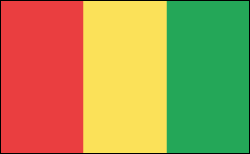|
Geography
 Guinea, in West Africa on the Atlantic, is also bordered by Guinea-Bissau, Senegal, Mali, Côte d'Ivoire, Liberia, and Sierra Leone. Slightly smaller than Oregon, the country consists of a coastal plain, a mountainous region, a savanna interior, and a forest area in the Guinea Highlands. The highest peak is Mount Nimba at 5,748 ft (1,752 m).
Guinea, in West Africa on the Atlantic, is also bordered by Guinea-Bissau, Senegal, Mali, Côte d'Ivoire, Liberia, and Sierra Leone. Slightly smaller than Oregon, the country consists of a coastal plain, a mountainous region, a savanna interior, and a forest area in the Guinea Highlands. The highest peak is Mount Nimba at 5,748 ft (1,752 m). History
Beginning in 900, the Susu migrated from the north and began settling in the area that is now Guinea. The Susu civilization reached its height in the 13th century. Today the Susu make up about 20% of Guinea's population. From the 16th to the 19th century, the Fulani empire dominated the region. In 1849, the French claimed it as a protectorate. First called Rivières du Sud, the protectorate was rechristened French Guinea; finally, in 1895, it became part of French West Africa.
Guinea achieved independence on Oct. 2, 1958, and became an independent state with Sékou Touré as president. Under Touré, the country was the first avowedly Marxist state in Africa. Diplomatic relations with France were suspended in 1965, with the Soviet Union replacing France as the country's chief source of economic and technical assistance.
